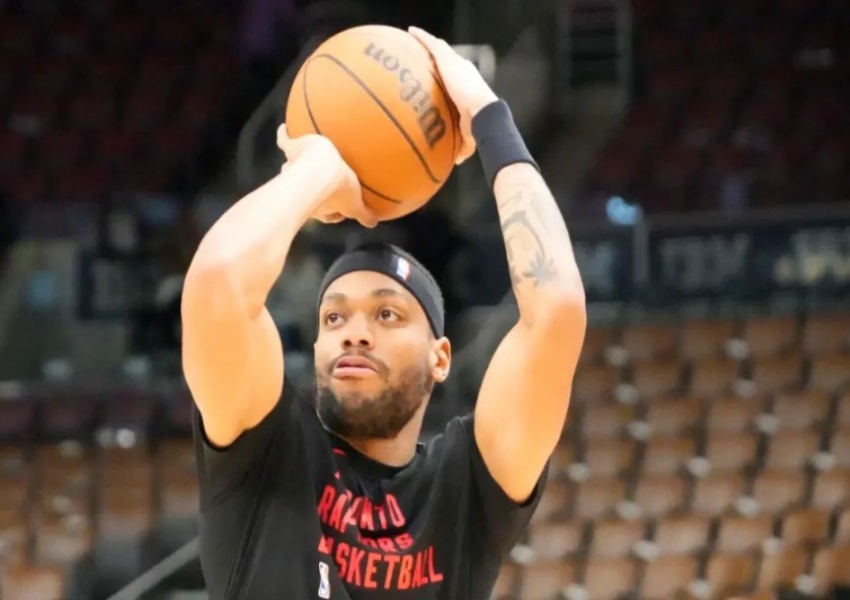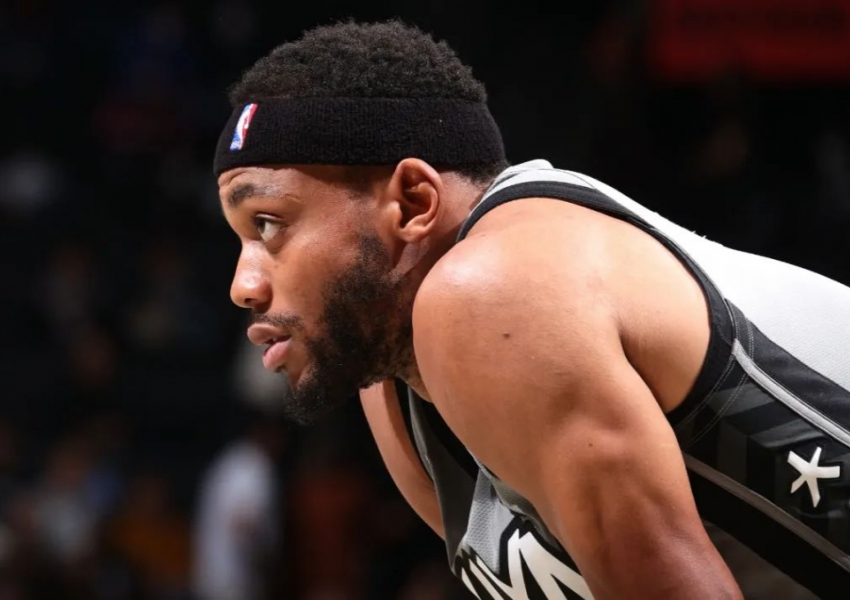Knee Surgery! Is Championship Role Player Bruce Brown Worth a First-Round Pick?
Recently, NBA insider Michael Scotto reported that Toronto Raptors forward Bruce Brown has undergone arthroscopic surgery on his right knee. He is expected to be re-evaluated in three weeks, which means he will likely miss training camp, preseason, and potentially the start of the regular season. Josh Lewenberg, another journalist covering the Raptors, later added that Brown’s knee issues had been ongoing since he joined the team. In a past interview, Brown himself stated, “It’s been tough, I could barely bend my knee. I was playing on one leg the whole time, and since December, I haven’t been the same.”

Like many NBA players, Brown seemed to follow a tactic famously mentioned by Shaquille O’Neal, who once said he never got surgery in the offseason, preferring to enjoy his time off and only dealt with injuries during the season. As a result, it’s common to see players undergoing procedures right before the new season begins, and Brown appears to be no different. However, it’s important to note that Brown is in a contract year, which could complicate his chances of securing a lucrative deal next summer.

Brown is well-known in NBA circles for his time with the Detroit Pistons and Brooklyn Nets, but it was his stint with the Denver Nuggets that truly made him a household name. During the 2022 offseason, Brown signed a two-year, $13 million deal with the Nuggets (the second year being a player option). In the following 2022-23 season, he became a vital piece in Denver’s championship run. He appeared in 80 regular-season games for the Nuggets, starting 49 of them, and averaged 11.5 points, 4.1 rebounds, 3.4 assists, and 1.1 steals per game. Brown shot 48.3% from the field, 35.8% from three, and 75.8% from the free-throw line, resulting in a 57.1% true shooting percentage.

Brown’s impact only grew during the playoffs, where he played 20 games and averaged 12.0 points, 4.0 rebounds, and 1.9 assists, with his shooting efficiency improving to 51.1% from the field and 60.7% true shooting. In the second round against the Phoenix Suns, Brown was instrumental in the pivotal Game 5, where he shot 7-for-11 from the field, including 2-of-4 from three, and hit 9-of-10 free throws en route to 25 points and 5 rebounds, leading the Nuggets to a crucial victory. In Game 4 of the Finals against the Miami Heat, Brown once again stepped up, shooting 8-for-11 from the field, 3-of-5 from three, and scoring 21 points with 4 rebounds and 2 assists to help Denver secure a 3-1 series lead.
Statistically, Brown was a game-changer during the Nuggets' playoff run. The team outscored opponents by 8.6 points per 100 possessions when Brown was on the floor, which was even better than starting guard Kentavious Caldwell-Pope (+6.2). Brown's impact was on par with star players like Michael Porter Jr. (+9.7) and two-time MVP Nikola Jokić (+9.7). Yet, despite Brown’s significant role in Denver’s success, he did not stay with the team after the championship.
The reason for Brown’s departure is simple: the Nuggets couldn’t afford him. Brown had only spent one season with Denver, so the team didn’t hold his Bird Rights, limiting them to offering a contract worth just over $7 million for one year. Meanwhile, the Indiana Pacers came forward with a much more lucrative offer: two years and $45 million. Given the choice between a short-term, low-paying deal and a sizable payday, it’s easy to see why Brown chose to move on from Denver.
The Nuggets sorely missed Brown during the 2023 playoffs. Denver’s lack of depth was painfully evident, particularly in the second-round Game 7 against the Minnesota Timberwolves, where the Nuggets’ bench contributed just 5 points. Brown’s departure exposed Denver’s thin rotation, underscoring just how important he had been to their title-winning roster.
After joining the Pacers, Brown quickly became a key piece of their starting lineup. He played 33 games for Indiana, all as a starter, and averaged 12.1 points, 4.7 rebounds, and 3.0 assists per game. His chemistry with point guard Tyrese Haliburton and center Myles Turner was clear, as the Pacers thrived with the trio on the floor. In the 555 minutes that Brown, Haliburton, and Turner played together, the Pacers scored an impressive 129.5 points per 100 possessions and outscored opponents by 11.4 points per 100 possessions.
Despite his solid play in Indiana, Brown’s time with the Pacers was short-lived. The team eventually set its sights on acquiring Toronto Raptors forward Pascal Siakam, and Brown was included in the trade package that sent him to Toronto. His role with the Raptors was significantly reduced; in 34 games with the team, he started just 11 times and saw his averages dip to 9.6 points, 3.8 rebounds, and 2.7 assists per game.
This decline in production can largely be attributed to the circumstances. The Raptors are a team in rebuilding mode, focused on developing young players like Scottie Barnes and RJ Barrett, rather than centering their future around a 28-year-old role player. While Brown was an integral part of a championship team just a year prior, his diminished role on a struggling Raptors squad was almost inevitable. For Toronto, Brown is not viewed as part of their long-term plans but rather as a potential trade asset. Rumors have swirled throughout the offseason that the Raptors are shopping Brown, hoping to acquire at least one first-round pick in return for his services.
However, there is some skepticism across the league about whether Brown is worth a first-round pick. While his versatility and championship experience are attractive, his $23 million annual salary makes teams hesitant. Brown's skillset—his ability to play multiple positions, from point guard to small forward, and even occasionally power forward—is valuable, but at his current price, teams are understandably reluctant to give up a first-rounder.
In Brooklyn, Brown was utilized as a small-ball forward, and during his second season with the Nets, he played 9% of his minutes at the power forward position despite standing only 6’4”. His defensive versatility and ability to contribute on both ends of the floor made him an invaluable piece in Denver’s title run, where he often guarded opposing stars while also providing offensive punch off the bench. This type of player—one who can adapt to multiple roles and contribute in a variety of ways—is exactly what contenders look for when assembling their rosters for deep playoff runs.
However, there’s no denying that Brown’s contract complicates his value on the trade market. A player making $7 million per year, like Brown was in Denver, is much more appealing than one making $23 million per year. Teams will likely be cautious in parting with a first-round pick for a player who, while effective, may not fit seamlessly into their financial plans. Brown's injury status only adds to the uncertainty, with his recent knee surgery likely pushing potential suitors to take a wait-and-see approach before making any offers.
Still, it’s important to remember that the trade deadline is months away, and Brown could return to form before then. If he does, it’s highly likely that contending teams will show interest in acquiring him as a critical piece for their playoff push. Brown’s ability to guard multiple positions, handle the ball, and score efficiently from all three levels makes him an ideal role player for any team looking to contend for a championship. His playoff experience and championship pedigree further bolster his case as a player who could push a team over the top.
In the end, Brown is undoubtedly a valuable player, and there’s a good chance that he’ll be on the move before the February trade deadline. But whether he’s worth a first-round pick remains up for debate. His salary is a significant factor, and teams will need to weigh the cost of acquiring him against the potential reward. For now, the Raptors seem content to wait and see if any team is willing to meet their asking price. But as the season progresses and teams solidify their playoff aspirations, Brown’s name will almost certainly be at the center of trade discussions.
By the time April rolls around, it’s unlikely that Brown will still be wearing a Raptors jersey. Whether he’ll be worth the first-round pick Toronto is seeking remains to be seen, but one thing is clear: Bruce Brown, fresh off a championship run and now recovering from knee surgery, still has a lot to offer to a contending team.
Copyright Statement:
Author: focusnba
Source: FocusNBA
The copyright of this article belongs to the author. Reproduction is not allowed without permission.
Recommended Blog
- Suddenly Released! At 35, Is Derrick Rose’s Next Stop Retirement?
- Confirmed: Rose Steps Away from NBA After Contract Buyout – Grizzlies Take the Blame
- 7-for-1 Trade Scenario: Giannis to Join Forces with Curry? A Wild Deal in the Making
- Ready for 3x3 Basketball? Zhang Zhenlin Set to Join Fast! China’s Leading Forward Eyes New Challenge
- Spurs’ Bold 5-for-1 Trade for Butler? A Championship-Level Move Could Shake the NBA
- Championship, Extension, and a Porsche! Kendrick Nunn’s Journey After Disastrous Lakers Stint – Could He Return to the NBA?
- Signed! 55th Pick Isaiah Wong Joins the Utah Jazz – Could China Be Quick to Naturalize Him?
- He’s Married! Hu Jinqiu Scores 42 Points and 22 Rebounds in Asian Qualifiers – Is He the Future of China’s Frontcourt?
- Leonard Out for the Season? Clippers Poised to Tank for 2025 Top Prospect
- Knicks Make Another Signing! Double Insurance Deal Highlights an Eventful Summer for New York
Hot Blog
- Tension in New York? Mikal Bridges Calls Out Thibodeau’s “Plantation-Style” Rotation!
- Kevin Durant = Three First-Round Picks? In Just Two Years, the Suns Lost Big!
- Major Decline! What Is De'Aaron Fox’s True Level with the Spurs?
- Completely Out of the Rotation! Why 25-Year-Old Cam Reddish Can't Get on the Court Anymore
- A Miraculous Buzzer-Beater—But What Level Is Kawhi Leonard Really At Now?
- 4,000 Threes! Just How Impossible Is Stephen Curry’s Latest Record?
- $293M Supermax and an MVP? Is There Any Doubt Left for Shai Gilgeous-Alexander?
- $110 Million Over Two Years—Butler Was Worth Every Penny
- $418M for Luka Dončić? Is the Lakers' New Star Worth It?
- 31-21-22! Did Jokic’s Historic Triple-Double Just Reignite the MVP Race?